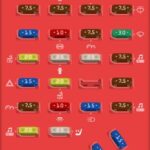The introduction of On-Board Diagnostics II (OBD2) was a game-changer for automotive repair. For 1997 Buick owners, understanding and utilizing the OBD2 port is essential for diagnosing car problems efficiently. If your “Check Engine” light illuminates in your 1997 Buick, the OBD2 port is your first step to understanding what’s wrong. This article will guide you to easily locate your 97 Buick Obd2 Port and understand how it can help you keep your vehicle running smoothly.
Where to Find the OBD2 Port on Your 1997 Buick
Locating the OBD2 port in your 1997 Buick is usually a straightforward process. The standardized placement of the OBD2 port was mandated to be within easy reach of the driver’s seat. For most 1997 Buick models, including popular models like the LeSabre, Park Avenue, and Century, you can typically find the OBD2 port in the following location:
- Under the dashboard, on the driver’s side: The most common location is beneath the steering column. You’ll likely need to crouch down and look under the dash, near where your knees would be while driving. The port is typically not hidden behind a panel, but openly accessible for easy connection.
- Look for a trapezoid-shaped, 16-pin connector: The OBD2 port is distinct in its shape – it’s a 16-pin, trapezoidal female connector. The unique shape ensures compatibility with all standard OBD2 scanners.
If you are having trouble locating it immediately, using a flashlight can be helpful to illuminate the area under the dashboard. Once you know what you’re looking for, the 97 Buick OBD2 port should be easily identifiable and accessible.
Why the OBD2 Port is Important for Your 1997 Buick
The OBD2 system is a powerful tool that monitors various systems within your 1997 Buick, from the engine and transmission to emissions control. When something goes wrong, the system often triggers the “Check Engine” light and stores diagnostic trouble codes (DTCs). These codes can be accessed through the OBD2 port using a scanner, providing valuable insights into the nature of the problem.
Here’s why understanding your 97 Buick’s OBD2 port is crucial:
- Quick Diagnostics: Instead of relying solely on visual inspections or guesswork, an OBD2 scanner quickly retrieves DTCs, pointing you or your mechanic directly to the potential issue.
- Cost Savings: Identifying the problem early can prevent minor issues from escalating into major, expensive repairs. Knowing the DTCs can also help you communicate effectively with mechanics, ensuring you’re getting the right service.
- Emissions Compliance: OBD2 systems are designed to monitor emissions-related components. Addressing issues flagged by the OBD2 system helps ensure your 1997 Buick remains environmentally compliant and avoids potential emissions test failures.
- Vehicle Health Monitoring: Regularly scanning your 97 Buick’s OBD2 port can provide a snapshot of your vehicle’s overall health, allowing for proactive maintenance and preventing unexpected breakdowns.
Using an OBD2 Scanner with Your 1997 Buick
Once you’ve located the 97 Buick OBD2 port, using an OBD2 scanner is simple:
- Turn off your Buick’s ignition: Ensure the engine is off before plugging in the scanner.
- Plug the OBD2 scanner into the port: The scanner’s connector is designed to fit snugly into the OBD2 port.
- Turn the ignition to the “ON” position (without starting the engine): This provides power to the scanner and the vehicle’s diagnostic system.
- Follow the scanner’s instructions: Each scanner varies slightly, but generally, you’ll select the option to read codes. The scanner will communicate with your Buick’s computer and display any stored DTCs.
- Record the codes: Note down the codes displayed by the scanner. These codes are your key to diagnosing the problem.
An OBD2 port typically located under the dashboard of a vehicle.
After retrieving the codes, you can research them online or consult a repair manual to understand their meaning. Websites like cardiagnosticnearme.com offer resources to help you interpret OBD2 codes and find qualified mechanics near you if needed.
Common Diagnostic Codes for 1997 Buick Vehicles
While the specific codes can vary depending on the model and issue, some common types of diagnostic trouble codes you might encounter in a 1997 Buick include:
- P0171 & P0174 (System Too Lean): These codes often indicate issues with the fuel system or vacuum leaks, leading to the engine receiving too much air or too little fuel.
- P0300 Series (Misfire Codes): Codes like P0300, P0301, P0302, etc., point to engine misfires, which could be due to spark plug problems, ignition coil issues, or fuel injector faults.
- P0400 Series (EGR System Codes): These relate to problems with the Exhaust Gas Recirculation (EGR) system, which is crucial for emissions control.
- P0420 (Catalyst System Efficiency Below Threshold): This common code often suggests a problem with the catalytic converter’s efficiency, potentially impacting emissions and performance.
- B, C, and U Codes: While P-codes (Powertrain) are most common for engine-related issues, you might also encounter B-codes (Body), C-codes (Chassis), and U-codes (Network Communication) for other system malfunctions.
Understanding these common code categories and researching the specific codes you retrieve from your 97 Buick OBD2 port will empower you to take informed steps towards diagnosing and resolving car problems.
Conclusion
The OBD2 port in your 1997 Buick is a valuable access point to your car’s computer and diagnostic information. Knowing how to locate and use this port with an OBD2 scanner can save you time and money on car repairs. By taking advantage of the OBD2 system, you can stay informed about your 97 Buick’s health, address issues promptly, and ensure your vehicle continues to provide reliable transportation for years to come. Remember to consult resources like cardiagnosticnearme.com for further assistance in understanding diagnostic codes and finding local repair solutions.
